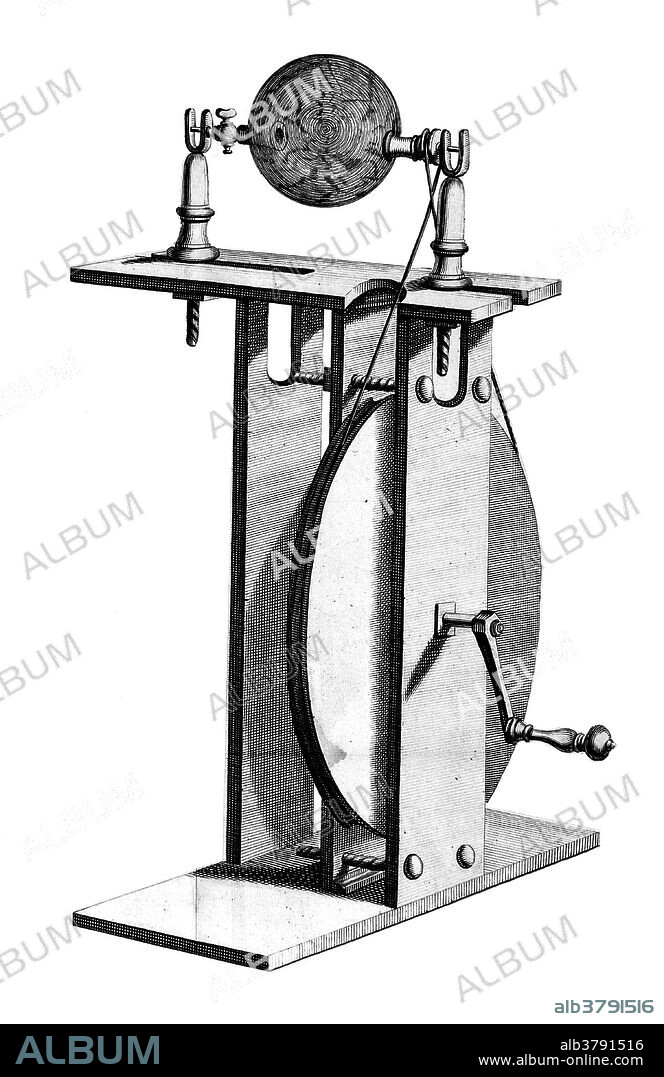alb3791516
Hauksbee Electrostatic Machine, 1709

|
Add to another lightbox |
|
Add to another lightbox |



Buy this image.
Select the use:

Title:
Hauksbee Electrostatic Machine, 1709
Caption:
Francis Hauksbee the Elder (1660-1713) was an English scientist. In 1678 he became Isaac Newton's lab assistant. In 1703 he was appointed curator, instrument maker and experimentalist of the Royal Society. In 1705 Hauksbee discovered that if he placed a small amount of mercury in the glass of his modified version of von Guericke's generator, evacuated the air from it to create a mild vacuum and rubbed the ball in order to build up a charge, a glow was visible if he placed his hand on the outside of the ball. The glow was bright enough to read by. This effect became the basis of the gas-discharge lamp, which led to neon lighting and mercury vapor lamps. In 1706 he produced an 'Influence machine' to generate this effect. He continued to experiment with electricity, making numerous observations and developing machines to generate and demonstrate various electrical phenomena. In 1709 he published Physico-Mechanical Experiments on Various Subjects which summarized much of his scientific work.
Credit:
Album / Science Source / Wellcome Images
Releases:
Model: No - Property: No
Rights questions?
Rights questions?
Image size:
3017 x 4650 px | 40.1 MB
Print size:
25.5 x 39.4 cm | 10.1 x 15.5 in (300 dpi)
Keywords:
1700S • 1709 • 18TH CENTURY • 18TH CENTURY, THE • 18TH CENTURY. • 18TH • APPARATUS • ART • ARTWORK • BW • CELEBRITIES • CELEBRITY • DEVICE • DRAWING • ELDER • ELECTRIC • ELECTRICAL • ELECTRICITY • ELECTRO-MAGNETISM • ELECTRO-MECHANICAL GENERATOR • ELECTRO-MECHANICAL MACHINE • ELECTRO-STATIC GENERATOR • ELECTRO-STATIC MACHINE • ELECTRO-STATICS • ELECTROMAGNETISM • ELECTROMECHANICAL GENERATOR • ELECTROMECHANICAL MACHINE • ELECTROSTATIC GENERATOR • ELECTROSTATIC MACHINE • ELECTROSTATICS • ENERGIA • ENERGY • ENGLISH • EQUIPMENT • EUROPEA • EUROPEAN • EUROPEANS • FAMOUS PEOPLE • FAMOUS • FRANCIS HAUKSBEE • FRANCIS HAWKSBEE • GENERATOR • HAUKSBEE ELECTRO-STATIC MACHINE • HAUKSBEE ELECTROSTATIC MACHINE • HAUKSBEE • HAWKSBEE ELECTRO-STATIC MACHINE • HAWKSBEE ELECTROSTATIC MACHINE • HAWKSBEE • HISTORIC • HISTORICAL • HISTORY • ILLUSTRATION • ILLUSTRATIONS • IMPORTANT • INSTRUMENT MAKER • INVENTION • MACHINE • MAGNETISM • NOTABLE • PHYSICS • SAVANT • SCIENCE • SCIENTIFIC • SCIENTIST • STATIC ELECTRICITY • WELL-KNOWN • XVIII CENTURY
 Pinterest
Pinterest Twitter
Twitter Facebook
Facebook Copy link
Copy link Email
Email
